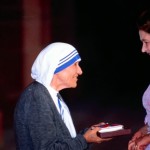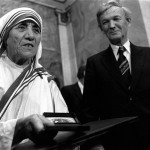Mother Teresa (Albania-India)
1979 Nobel Peace Prize Laureate, the prize awarded for her activity helping the suffering mankind.
«God sends us trials to overcome, so that we may be strengthened, and not despair!».
(Mother Teresa)
Mother Teresa was born on August 27, 1910, in Skopje. (To be more exact, she was born not on the 27th, but on the 26th. On August 27, she was baptized, and that day, the day of her baptism, Mother Teresa considered the day of her birth.) Her parents were Catholic, while most Albanians in that part of the country adhered to Islam. At that time, Skopje was part of the Ottoman Empire; then it became part of Yugoslavia. Now it is the capital of Macedonia. She was born Agnes Gonxha Bojaxhiu.
“I had a happy childhood,” — said Mother Teresa herself later. Gonxha’s parents were Albanians. They settled in Skopje in the very beginning of the 20th century. The father — Nicholas Bojaxhiu, was a co-owner of a large construction company, and a prosperous merchant. He was also a member of the municipal council, knew many languages, travelled frequently, and was greatly interested in politics. Agnes knew no need, while she was living in her parent’s home. The family was not only wealthy, it was also happy, and really close-knit.
There were three children in the family: apart from Agnes Gonxha, the parents also had the eldest son Lazarus, and daughter Agatha. All the children were very attached to each other and played together a lot. Later, Lazarus recalled that as a child, Agnes Gonxha was a little pink plump girl, who was also very risible. That was the reason why she was called at home Gonxha, which in Albanian means “flower bud.”
Gonxha’s mother, nee Dranafile Bernai, was a very beautiful woman. Being a devout Catholic, she often took her daughters to the worship services in the church, and visited the sick and the needy together with them.
In 1919, when Gonxha was nine years old, her father died under vague circumstances. He was an active figure in the Albanian liberation movement, and fought for Skopje to become part of Albania. According to one of the versions, he was poisoned by the Yugoslav police.
Dranafile had to raise three children on her own. To keep the children from want, she sewed wedding dresses, embroidered, and did all kinds of hard work. As busy as she was, she found the time to bring up her children. They prayed every night, went to church every day, and helped in carrying out the worship services to the Holy Virgin Mary. Agnes loved to visit the church. There she read, prayed, and sang.
The poor could always find shelter, warmth, and understanding at the Bojaxhiu’s home. Gonxha’s mother looked after an alcoholic woman who lived next door, brought her food twice a day, and cleaned her house. She took care of the widow with six children. Sometimes Dranafile did not have time to do everything herself, and Agnes did this charitable work in her stead. After the widow died, her children grew up in the house of the Bojaxhiu, as if they were part of the family.
Lazarus won a scholarship to study in Austria, Agatha was admitted to a private school, and Agnes — to a state school. She was a good student. Together with her sister, she sang in the church choir: Agnes was soprano, and Agatha — the second. Gonxha also played the mandolin.
Gonxha spent much time in the Order of the Blessed Virgin Mary. She helped the priest, who did not know the languages, and read a lot about the Slovenian and Croatian missions in India. Every year the girl would make a pilgrimage to Montenegro. There, before the icon of the Blessed Virgin Mary, for the first time, she felt the call to serve God. But a twelve year old girl then did not want to become a nun, and she stifled this inner voice.
Later, Agnes prayed much, and told her mother and sister about what had happened. Some time later, she asked a priest how she could be sure whether she really heard the voice of God, to which he replied: “Listen to your heart. If you are really happy to know that God has called you to serve Him, serve Him and your neighbour, then it means, that it really was the call. The joy in your heart is the compass that will show you the way in your life.”
In 1928, Gonxha graduated from high school in Skopje, and wondered about her future. In choosing her life path, she was influenced by her contacts with the Brotherhood of Our Blessed Lady — an organization that helps the poor in different countries. One day, while listening to the parish priest reading the letters from missionaries in India, Gonxha became interested in the activities of the Bengali mission.
Again, young Agnes Gonxha heard an inner voice. It encouraged her to become a missionary in India. This time she did not resist the call of her heart. After pious meditations and prayers, she decided to “go and tell about the life of Christ to people.” The only way that made it possible for her to realize this dream was to join the congregation of missionaries. Gonxha had to go to Dublin and join the Irish Order of the Sisters of Loreto, which had a mission in India. (The Order received its name from the city of Loreto in Italy. According to tradition, it was into this city that the angels carried the house, where the Mother of God lived.) On the day of her departure, September 25, 1928, the whole community accompanied her to the station: friends, classmates, neighbours and, of course, her mother, and sister Agatha (who later became a translator and radio announcer). There were tears in the eyes of those who came to see her off.
The train took her to Zagreb; then via Austria, Switzerland, and France, she travelled to London, and from there — to the abbey near Dublin, where the Order of the Sisters of Loreto is located. There Gonxha spent about two months studying English. On December 1, 1928, eighteen-year-old Agnes Gonxha sailed from Dublin to Calcutta. The journey was a very long and tedious one. She had to celebrate Christmas without a Christmas tree, on shipboard. In the beginning of 1929, they reached Colombo, Madras, and then, finally, Calcutta. From there she went to Darjeeling — a small town in the foothills of the Himalayas. There, among the majestic snow-capped mountains, was a monastery of the Order of Sisters of Loreto. In this monastery Agnes held her novitiate period, in preparation for taking the veil. Two years later she was sent to help the sisters care for the sick at a small hospital in Bengal. Endless suffering, and misery of the people from poor neighbourhoods shocked the young girl.
When the period of her novitiate came to an end, Agnes was sent to teach history and geography at the school of St. Anne in Calcutta. It was a clean, well-equipped monastery school for girls from wealthy families. The children fell in love with her very soon, because of her tenderness, and unswerving enthusiasm, and the number of her pupils gradually reached three hundred. For her care and love, the children started calling Agnes “mom.”
Working at the school with the sisters of Indian descent, she learned Hindi and Bengali. Then, visiting the sick in hospitals and beggars in the slums together with her students, she first encountered the terrible poverty of Calcutta. But it was not yet the time for Mother Teresa’s righteous labour for the poor, which made her famous throughout the world.
On May 24, 1937, Agnes took monastic vows and became a principal of the Bengali branch of the school of St. Anne. She took the monastic name Theresa in honour of Saint Theresa de Lisieux, a nineteenth-century French nun who sought to do good, happily carrying out the most unpleasant work.
The monastery of Loreto allowed to lead a solitary way of life and to give oneself completely to the service of the Lord. But the school where Mother Teresa worked was near the Calcutta slums. Every day the nun saw the horrors of hunger, poverty, and disease. Together with her students, Sister Teresa not only regularly visited hospitals and slums, not only prayed for the weak and the poor. She had serious conversations with her pupils about what they had just seen. Her spiritual mentor, who encouraged Teresa to her noble work, was a Jesuit father, who came from Belgium, Henry.
For many more years, he would shape Sister Teresa’s view on life. It was under his positive influence that the young nun had the desire to do everything possible for the poor.
On September 10, 1946, Mother Teresa went to the annual Holy Fast in Darjeeling. She expected to stay there for a while to rest and recover: doctors suspected that she might have tuberculosis. Later, Sister Teresa called this trip “the most important journey” in her life.
Lulled by the rhythmic rattle of the train’s wheels heading for Darjeeling, she dozed off. Suddenly Mother Teresa was awakened by a voice she heard. But all the passengers in the car were silent. The voice was inside her, within her being. “Go and live among the poor, and I will be with you,” Mother Teresa heard. It was a Divine Inspiration, the meaning of which was clear to her. She recalled later: “I had to leave the monastery and live among the poor, helping them. It was an order from above, from God Himself. Now I knew what to do, but I did not know how … “
Upon her return from Darjeeling to Calcutta, Mother Teresa told Mother Superior about everything. But the latter did not take her desire to leave the monastery seriously, and spoke about this quite harshly: “What an absurd dreaming!”











